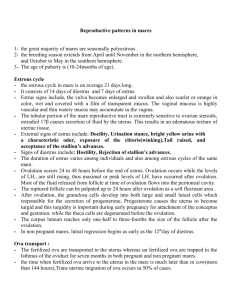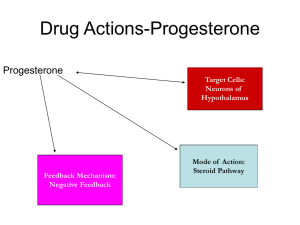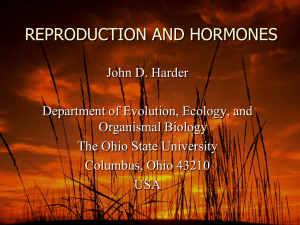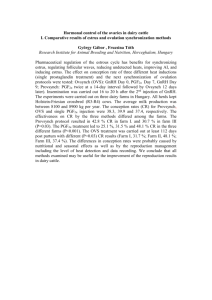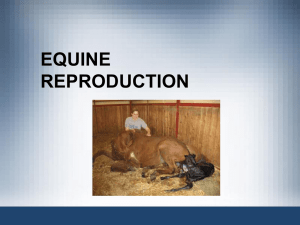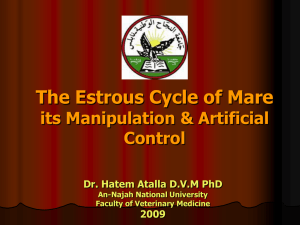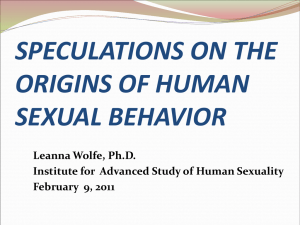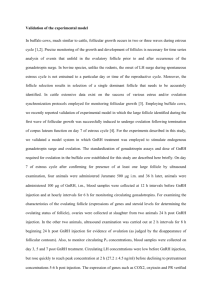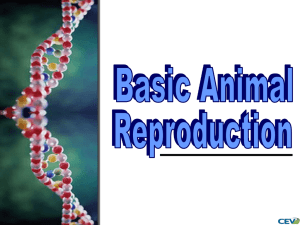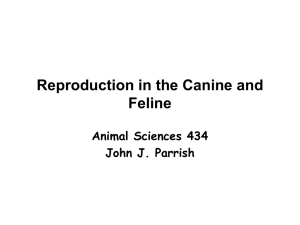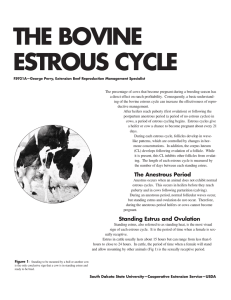Reproductive Physiology of the Mare
advertisement
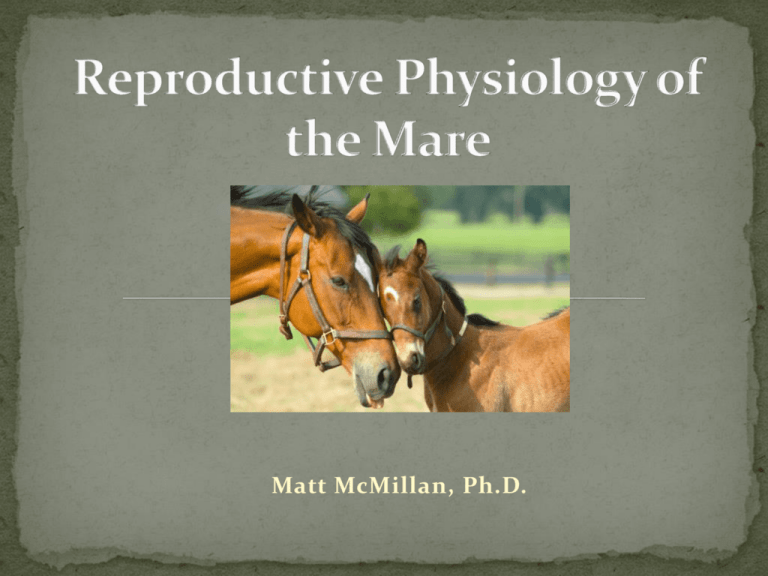
Matt McMillan, Ph.D. Includes: Vulva Vagina Cervix Uterus Oviducts Ovaries Consists of: Labia, Clitoris, Vestibule Purpose? Protect from entrance of air & other contaminants What may poor conformation may lead to? Pneumovagina or windsucking Caslicks Labia Vertical slits below anus Purpose? Helps to seal the vestibule from the external environment Clitoris Located? Inside labia Can be seen during winking Vestibule Internal portion of the vulva Hymen may be present in this area Glands secrete mucus to lubricate vulva and vagina Vagina 6-8 inches long Connects vestibule to cervix Cervix Acts as a physical barrier between vagina and uterus Shape changes in response to body’s hormonal environment Estrus (estrogen): very pink, vascular, relaxed Diestrus (progesterone): very thick, sticky mucus, tightly closed Uterus Hollow Y shaped organ including uterine body Influenced by? Hormones Function is to: Protect and Nourish Provide a conducive atmosphere for development of embryo Expel fetus during birth Oviducts (aka?) Fallopian tubes Fertilization of ovum Ovary Vary in size and texture due to time of year Hormone production Follicle growth Ovulation (Occurs When?) (~35mm) Corpus Luteum (What Hormone is Produced?) Progesterone Reproductive efficiency is very low (Why?) Live foal versus bred mares ~50% Leading cause of infertility is Human management Live foal rates in feral horses ~80-90% Why is reproductive efficiency so poor? We tend to: Select for other than reproductive characteristics Frequently attempt to breed out of season Horses are short day or long day breeders? Gestation period? During winter months mares are anestrus Not respond to stallion Ovaries will not develop follicles Minimal ovarian hormone secretion During season of reproduction: Estrous cycles 21-23 days Estrus (heat period) Responsive to stallion 5 to 7 days Signs include: Urination stance, leaning into stallion, winking Estrus behavior will cease 24-48 hours after ovulation Beginning of diestrus 14-16 days Processes involved in reproduction in the mare are driven by what? Hormones What are Hormones? Chemical substances produced by various tissues that travel through the circulatory system to produce an effect on an organ (s) Endocrinology Study of hormones and their effects Hypothalamus Located where? in mid-brain Interprets environmental cues such as Day length Temperature Signals start of season by producing GnRH Stimulates anterior pituitary Anterior pituitary produces FSH and LH Stimulates ovaries Follicle Stimulating Hormone (FSH) Stimulates the growth of follicles Dominant follicle is selected ~20-25 mm Estradiol-17β is secreted Peak immediately prior to ovulation Stimulates release of LH Luteinizing Hormone (LH) Responsible for stimulating ovulation Supporting initial stages of Corpus luteum (CL) development Secreted for a prolonged period in the mare Beginning before the initiation of estrus Reaches peak concentrations two days after ovulation The lutueal phase of the estrous cycle begins with: The completion of ovulation After ovulation occurs: The ruptured follicle tissue begins to form the CL The empty follicular cavity accumulates coagulated blood and forms The corpus hemorrhagicum (precursor to CL) Luteal cells begin to replace blood: CL is formed CL secretes what? Progesterone What is the purpose of progesterone? Maintain pregnancy Inhibits the release of LH Changes behavior into a typical diestrus state For the mare to return to estrus Progesterone must be halted If mare is not pregnant: PGF2α is released from the uterus 14 to 16 days following ovulation PGF2α causes? Luteolysis marking the end of the luteal phase Primary environmental cue used in reproductive activity is: Day length Length of photoperiod is interpreted through: Neural signals to specific portions of the brain creating hormones to be produced or ceased Melatonin is produced where? Brain’s pineal gland In response to absence of light Melatonin has suppressive effect on? GnRH During Anestrous: Melatonin levels are High GnRH levels are Low LH levels are Low FSH levels do not appear to change with the seasons Ovaries are: Small and hard during anestrus with no significant follicular activity Research: Spring vs. Fall Spring has been researched more to increase the production of early-season foals Mares placed under lights to stimulate estrus Deslorelin (Ovuplant) Desorelin Acetate(Sucromate) Injectable GnRH agonist Stops production of testosterone and estrogen Induces ovulation within 48 hours of treatment in cyclic estrous mares with an ovarian follicle between 30 and 40 mm in diameter hCG Human Chorionic Gonadatropin Has LH properties Causes ovulation Altrenogest Regumate Synthetic Progesterone aka progestine Given daily for 15 days Keeps mares from entering estrus When discontinued Return to estrus within 4 to 5 days
